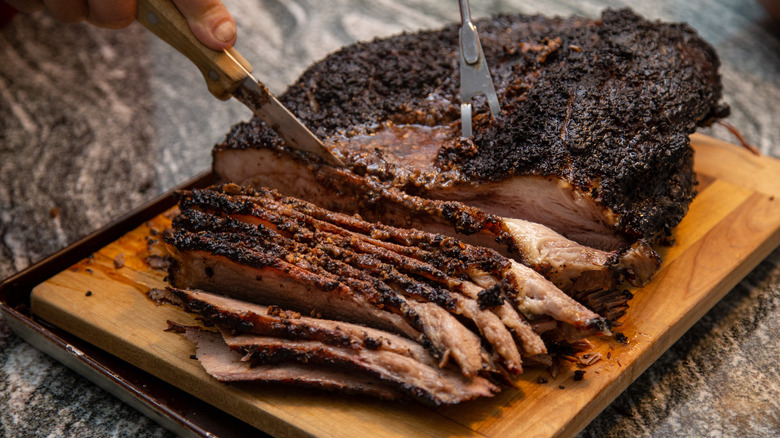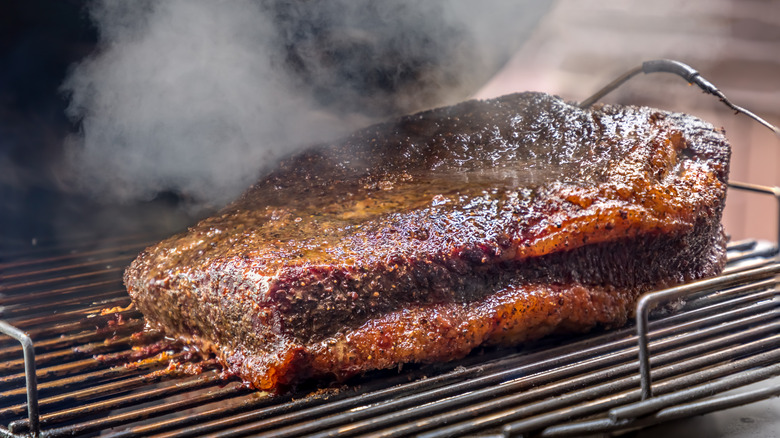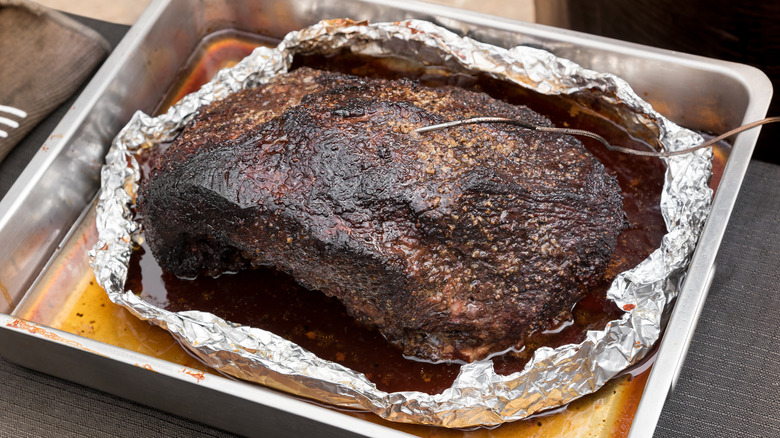The 3-2-1 Method You Should Know For A Better Passover Brisket
Brisket makes a tasty celebratory dinner to feed a crowd and is perfect for Passover or other holiday meals (looking at you, Rosh Hashanah) as it comes from the front of the animal (and is thus kosher) and can often be cooked ahead of time and reheats well. But this particular cut of beef can also be tricky to prepare, so it achieves a moist, tender texture. As it comes from the breast of the animal, the beef needs low-and-slow cooking, so it doesn't become tough. A great way to do this is to smoke it. Put that slow cooker away.
A good way to stop brisket from becoming overcooked when smoking is to wrap the meat in foil or butcher paper as it cooks. This has several advantages, including protecting the beef from drying out, tasting overly smoky, and speeding up the cooking process. But to really smoke brisket like a pro, the best way is to use the 3-2-1 method — three cooking times to guarantee tender, flavorsome meat perfect for your seder.
Often used for other meats that require long, slow cooking on the barbecue, such as ribs, the 3-2-1 method essentially involves firstly smoking the meat as it is for three hours, wrapping it for the second two hours, and finally finishing the cooking unwrapped for the last hour. And the separate stages make it especially easy to follow for a fuss-free cooking method that's ideal when you're preparing for Passover.
The 3-2-1 method enhances the taste and tenderness of brisket
The 3-2-1 method is ideal when smoking brisket because each stage works to both flavor the beef and to melt the collagen within the tough cut to turn it tender. Brisket can be divided into two parts — the flat or deckle of beef, which is leaner — and the point cut, which is fattier; however, both are tough. The brisket cut for the best barbecue according to pitmaster Aaron Franklin is the packer cut, which combines both. But whichever you choose, the 3-2-1 method works well to bolster the taste and texture of the meat.
The first stage of the technique means that the brisket has a chance to slowly absorb the superb smoky flavors from the barbecue as it begins the cooking process unwrapped — and a dry, cured wood is the best type of wood to use for smoking brisket, enhancing the taste and tenderness. The beef should be wrapped once it has formed a deliciously dark bark, and the temperature has reached 165 degrees Fahrenheit. It then retains moisture within the parcel and begins to braise.
For the final stage, the meat is unwrapped and cooked at a slightly higher temperature, so it forms a good crust. Brisket takes around one to one-and-a-half hours to smoke per pound of meat, so if you're following the 3-2-1 ratio, just adjust the timing according to the size.
More ways to cook Passover brisket so it stays tender
Smoking is not the only way to cook tender, juicy brisket; if you want to try a different spin on the method, you can even smoke brisket indoors using a sous vide set-up; just bear in mind it's a lengthy process. But if you'd rather try a different technique, there are plenty of more traditional options that produce equally tasty results for your Passover Seder.
Slowly cooking brisket in the oven is a great method for tender meat, and takes around 18 minutes per pound, but there are a couple of steps to follow; like the 3-2-1 method, they involve stages where the meat is uncovered and then covered. Try cooking the seasoned brisket at 425 degrees Fahrenheit for the first hour to develop a good crust. Then turn the heat down to 300 degrees Fahrenheit, add your marinade or broth, cover with foil, and let it slowly braise for at least two and a half hours or until tender. You can cook brisket the day beforehand to make things easier on the day. Simply slice the cooled meat against the grain, place it back in its juices, and refrigerate it. Reheat it gently until it reaches 165 degrees Fahrenheit to serve (via the USDA).
Or use a slow cooker for another simple method. A three-pound brisket will take 10 to 12 hours on low heat, and the juices can be used to make a delicious sauce. Chag sameach!



